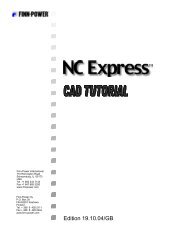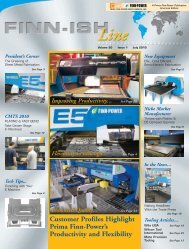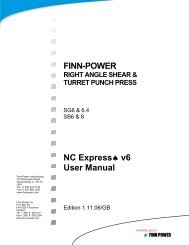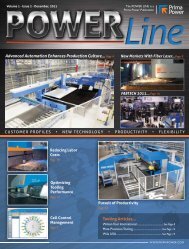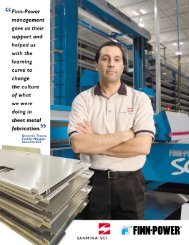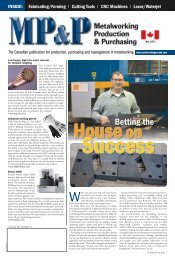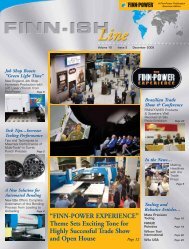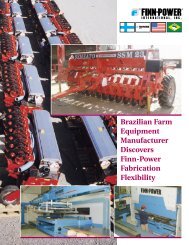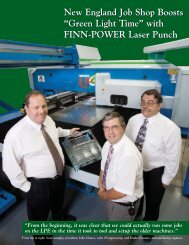Stand-Alone Punch machine user manual - Finn-Power International ...
Stand-Alone Punch machine user manual - Finn-Power International ...
Stand-Alone Punch machine user manual - Finn-Power International ...
You also want an ePaper? Increase the reach of your titles
YUMPU automatically turns print PDFs into web optimized ePapers that Google loves.
4.4 Automatic Tooling (Autotool)<br />
The Autotooling function is a fully automatic tooling system that works in<br />
conjunction with the CAM database to place tooling on geometric entities. Autotool<br />
breaks the part geometry into predefined features (geometric entities). It then<br />
proceeds to tool these geometric entities according to tolerance settings and priority<br />
of tools set in the Tool library. Autotool requires minimum input from the <strong>user</strong>; at the<br />
same time, it gives enormous flexibility in tooling the parts. Nibbling and punching<br />
priorities from the Tool library are used to distinguish which tools will be used first.<br />
Tolerance levels are used to set tolerance limits for each type of geometric shape.<br />
The information within this section is tailored to the application of tooling parts for a<br />
<strong>Finn</strong>-<strong>Power</strong> <strong>Stand</strong>alone <strong>machine</strong> utilizing the Autotool feature within NC Express.<br />
CAM Database<br />
Settings<br />
Variational Tooling<br />
Sorting<br />
Preshear part<br />
Common line Part<br />
Single part<br />
Autotool Exercise<br />
4.4.1 CAM Database (CAM.mdb)<br />
Autotool has a variety of settings (Autotool, Nesting, Optimization, and Post<br />
processing parameters) that can be edited for each material type and thickness<br />
loaded for a particular <strong>machine</strong>. In order to remember each of the settings per<br />
material type and thickness there is a database in the background that stores the<br />
settings within for each type and thickness. The database that holds this<br />
information is named CAM.mdb. Each time a part is created or opened, the<br />
material type and thickness settings are then accessed from the database. When<br />
Autotool is opened the settings that were saved to the database last are then opened<br />
and loaded in Autotool dialog. Settings for each material type and thickness are<br />
saved when switching between them or closing NC Express (explained in next<br />
section).<br />
4.4.1.1 Saving Settings to CAM Database<br />
When a setting within NC Express (ex. Autotool parameter) has been changed<br />
that is stored within the CAM database NC Express will ask if the <strong>user</strong> wants to<br />
save the settings for the material type and thickness that was being used. NC<br />
Express will ask to save when material type and thickness is being changed<br />
within the system or when NC Express is being closed. Below is a screen shot<br />
of the message that will appear when the system will ask to save settings.<br />
4-43




